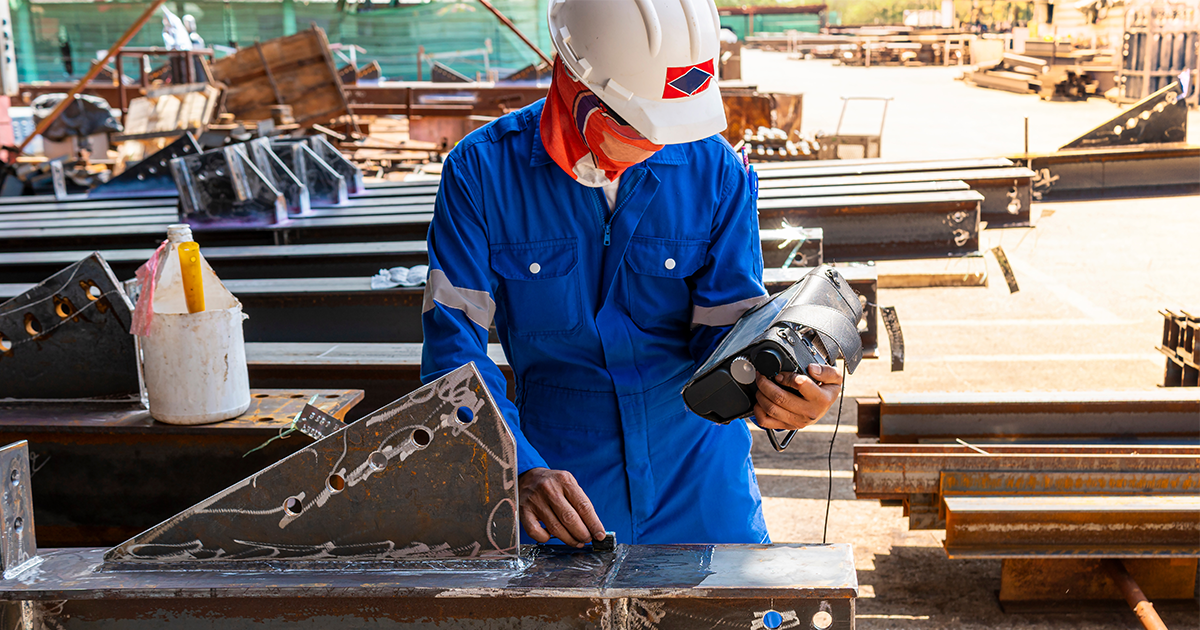

Materials testing: The basics
Materials science and its associated tests are largely considered a part of the applied science branch of sciences, as the study and testing of the properties of materials are put to use in the manufacture and construction of a wide variety of items. Testing methodologies can be divided into the analysis of physical, mechanical, chemical, and biological properties, with each test falling under the category of destructive or non-destructive. Testing of a material may involve one or more of these methodologies, and occasionally all of them may be used as part of a comprehensive analytical approach towards a material.[1][2]
Material testing may happen under the umbrella of materials discovery and research, or materials quality/suitability testing. In the case of the former, computational methods may initially be used to search through existing materials databases, as well as virtually develop new material models for potential real-life development, before any actual real-world materials testing begins. In the case of the latter, the material is already discovered or created, and materials testing occurs to verify that a material’s properties are suitable or of sufficient quality for their intended purpose. Technological systems such as laboratory information management systems (LIMS) may be used in both cases to better manage the associated data and information coming from their associated materials science activities.
Materials testing is as diverse as the available material types and industrial applications of those material types. Material testing domains include:
- Aerospace
- Automotive
- Carbon
- Coatings, linings, and sealants
- Construction and engineering
- Insulation, foam, and composites
- Lubricants and thickeners
- Medical devices
- Metals
- Packaging and labeling
- Paints and oils
- Paper
- Polymers and plastics
- Raw materials
- Reference materials
- Rubbers
- Electronics and energy devices
- Textiles
- Wood
Optimally, materials testing is performed by a laboratory that is accredited to a relevant set of standards and test methods, making materials testing more standardized and reliable, in turn adding confidence to any items made or constructed from those tested materials.
Materials testing types
As noted prior, the diversity in materials testing methods is immense. As such, it’s difficult to address all of them in an FAQ. That said, this article will provide examples of destructive and non-destructive test methods across the four categories of test properties: physical, mechanical, chemical, and biological. (Note that in a few cases, a test might be destructive or non-destructive, depending on the particulars, for example as found with hardness, thickness, and crimp (length) testing, which are physical tests.[3][4][5][6] However, also note that physical tests aren’t commonly destructive, and the classification of a biological test as destructive or non-destructive can be challenging.) Real-world examples from materials testing laboratories accredited to ISO/IEC 17025 are used to exemplify the broad set of test methods in use.
Physical
A physical property of a material represents the actual physical, inconstant state of the material, with its own set of measurable and observable properties, separate from the material’s chemical composition, mechanical, and biological properties.[7]
Non-destructive physical tests include[8][9][10][11][12][13][14]:
- visual testing
- magnetic particle testing
- resonant ultrasound testing
- color tolerance and difference
- specular gloss

- solar reflectance index
- apparent density
- water vapor transmission
- ultrasonic defect testing
- thermogravimetric analysis
- infrared thermography
- airflow resistance
Tests that can be both destructive and non-destructive physical tests include[3][4][5][6]:
- hardness
- dry film and other coating thickness
- yarn crimp percentage (length)
Mechanical
A mechanical property of a material represents the functional, inconstant state of the material, particularly in how it reacts when a load is applied to it. Measuring mechanical properties gives a better idea of the material’s realistic service life or performance under mechanical stresses.[7] Mechanical testing is frequently destructive in nature.
Destructive mechanical tests include[7][11][15][16][17]:
- scratch adhesion testing
- flattening testing
- flaring testing
- burst strength
- tear strength
- peel strength
- bend testing
- tensile bond testing
- concentrated impact
- compressive resistance
- abrasion resistance
Chemical
A chemical property of a material represents how the material reacts under the duress of outward pressures, which fundamentally change the material into a different material over a period of time.[18] As an example, one can turn to the principal of using a sacrificial anode to prevent the corrosion of a principle metal, with the anode being chemically altered into another substance rather than the principle metal. This method may be used if the principle metal’s chemical property of “corrosion resistance” is low.
Destructive chemical tests include[15][18][19][20]:
- corrosion resistance
- flammability
- galvanized coating weight
- leaching
Non-destructive chemical tests include[21][22][23]:
- liquid dye penetration
- chemical composition through spectrometry, spectroscopy, or X-ray fluorescence
- surface tension
- temperature-compensated viscosity
Biological
In the scope of testing quality and suitability of raw materials used in the production of an item, a biological property of a material represents how the material reacts to one or more aspects of a biological organism, or how a biological organism reacts to the introduction of the material. Examples of biological properties include[24]:
- toxicity, “the degree to which a material may permanently destroy or impair any part of biological organism;
- bioinertness, the ability of some material to go unchanged and elicit biological activity upon introduction to a biological organism; and
- bioactivity, the ability of a material to “elicit or modulate a favorable response” from one or more systems of a biological organism.
One school of thought has that in vitro testing of biological samples is non-destructive (as with bacterial endotoxins testing[25]). However, one might argue that in some cases the in vitro biological sample being tested must be altered destructively, or even that microbes are living biological entities, which may get destroyed in specific bioburden test types.[26] As such, these tests’ classification as “destructive” or “non-destructive” may be viewed with some skepticism.
Destructive biological tests include[26][27][28]:
- bioburden testing
- antimicrobial effectiveness
- microbial immersion
Non-destructive biological tests include[25][28][27][29][30][31]:
- bacterial endotoxin testing
- sterility testing
- cell and tissue characterization using ultrasound
- bioburden testing
References
- Shen, Ya; Peng, Bin; Yang, Yan; Ma, Jingzhi; Haapasalo, Markus (1 May 2015). [* https://onlinelibrary.wiley.com/doi/10.1111/etp.12076 “What do different tests tell about the mechanical and biological properties of bioceramic materials?”] (in en). Endodontic Topics 32 (1): 47–85. doi: 10.1111/etp.12076. ISSN:1601-1538.
- Kang, Tae-Yun; Choi, Ji-Won; Seo, Kyoung-Jin; Kim, Kwang-Mahn; Kwon, Jae-Sung (30 March 2021). [* Materials | Free Full-Text | Physical, Chemical, Mechanical, and Biological Properties of Four Different Commercial Root-End Filling Materials: A Comparative Study “Physical, Chemical, Mechanical, and Biological Properties of Four Different Commercial Root-End Filling Materials: A Comparative Study”] (in en). Materials 14 (7): 1693. doi:10.3390/ma14071693. ISSN: 1996-1944. https://www.mdpi.com/1996-1944/14/7/1693
- Bennett, M. (8 December 2022). “Michael Talks Metal Video 112: Hardness Testing”. Michlin Metals, Inc. Retrieved 01 November 2023. https://www.michlinmetals.com/hardness-testing-destructive-and-non-destructive-testing-ndt/
- Cohen, C. (5 February 2019). “Dry Film Thickness Measurement On Non-Metal Substrates”. BYK-Gardner Laboratories Blog. BYK-Gardner USA. Retrieved 01 November 2023. https://gardnerlaboratories.com/tag/destructive-film-thickness-tests/
- Haider, F I; Suryanto; Ani, M H; Mahmood, M H (1 January 2018). “A comparison between destructive and non-destructive techniques in determining coating thickness”. IOP Conference Series: Materials Science and Engineering 290: 012020. doi: 10.1088/1757-899X/290/1/012020. ISSN: 1757-8981. https://iopscience.iop.org/article/10.1088/1757-899X/290/1/012020
- Baby, Ruksana; Mathur, Kavita; DenHartog, Emiel (2 November 2022), Jeon, Han-Yong, ed., “Non-destructive Characterizations of Natural Yarns and Fabrics” (in en), Natural Fiber (IntechOpen). doi:10.5772/intechopen.102587. ISBN: 978-1-80355-213-2. Retrieved 2023-11-01. https://www.intechopen.com/chapters/80883
- Miranda, G.M. (14 February 2019). “What is the Difference Between a Physical Property and a Mechanical Property?”. AZO Materials . Retrieved 01 November 2023. https://www.azom.com/article.aspx?ArticleID=17626
- “Scope of Accreditation to ISO/IEC 17025:2017 – Product Assurance Services, Inc” (PDF). ANAB. 2 November 2021. Retrieved 01 November 2023. https://search.anab.org/public/organization_files/Product-Assurance-Services-Inc-Cert-and-Scope-File-11-02-2021_1635864735.pdf
- “Scope of Accreditation to ISO/IEC 17025:2017 – Charter Coating Service (2000) Ltd” (PDF). ANAB. 7 November 2022. Retrieved 01 November 2023. https://search.anab.org/public/organization_files/Charter-Coating-Service-2000-Ltd-Cert-and-Scope-File-11-07-2022_1667841835.pdf
- “Scope of Accreditation – R&D Services, Inc” (PDF). International Accreditation Service, Inc. 29 August 2022. Retrieved 01 November 2023. https://www.iasonline.org/wp-content/uploads/2017/05/TL-566-Cert-New.pdf
- “Scope of Accreditation to ISO/IEC 17025:2017 – Industrial Testing Laboratory Services” (PDF). A2LA. 1 June 2022. Retrieved 01 November 2023. https://customer.a2la.org/index.cfm?event=directory.detail&labPID=90975A9E-26BB-4DCC-921A-9786F504539D
- Zoppi, L. (6 January 2020). “An Introduction to Thermal Testing”. AZO Materials . Retrieved 01 November 2023. https://www.azom.com/article.aspx?ArticleID=18848
- Shirazi, A.; Karbhari, V.M. (2013), “Non-destructive evaluation (NDE) of composites: application of thermography for defect detection in rehabilitated structures” (in en), Non-Destructive Evaluation (NDE) of Polymer Matrix Composites (Elsevier): 515–541, doi: 10.1533/9780857093554.4.515. ISBN: 978-0-85709-344-8. Retrieved 2023-11-01. https://linkinghub.elsevier.com/retrieve/pii/B9780857093448500191
- “Scope of Accreditation to ISO/IEC 17025:2017 – Blachford Incorporated” (PDF). ANAB. 21 June 2023. Retrieved 01 November 2023. https://search.anab.org/public/organization_files/Blachford-Incorporated-dba-Blachford-Acoustics-Laboratory-Cert-and-Scope-File-06-21-2023_1687370807.pdf
- “Scope of Accreditation to ISO/IEC 17025:2017 – Vartest Laboratories, Inc” (PDF). A2LA. 31 October 2023. Retrieved 01 November 2023. https://customer.a2la.org/index.cfm?event=directory.detail&labPID=C07768C0-6BB2-4FAB-9D6D-C5D4F9D93403
- Praul, M. (27 June 2017). “Tensile Bond Tester, ACI 503.1R, ASTM C1583”. U.S. Department of Transportation, Federal Highway Administration. Retrieved 01 November 2023. https://www.fhwa.dot.gov/pavement/concrete/tensile.cfm
- “Scope of Accreditation to ISO/IEC 17025:2017 – Packaging Compliance Labs, LLC” (PDF). A2LA. 19 June 2023. Retrieved 01 November 2023. https://customer.a2la.org/index.cfm?event=directory.detail&labPID=390CCBB1-6EC1-41BE-B573-2BE1CE5F8812
- “Physical and Chemical Properties”. Physics of Nondestructive Evaluation. Iowa State University Center for Nondestructive Evaluation. Retrieved 01 November 2023. https://www.nde-ed.org/Physics/Materials/Physical_Chemical/PhysicalProperties.xhtml
- “Scope of Accreditation to ISO/IEC 17025:2017 – A-Lab Corp.” (PDF). A2LA. 22 December 2022. Retrieved 02 November 2023. https://customer.a2la.org/index.cfm?event=directory.detail&labPID=A3C7BB80-EFEF-47EF-A7C6-CB4389D35AF4
- “Scope of Accreditation to ISO/IEC 17025:2017 – Akron Rubber Development Laboratory, Inc” (PDF). A2LA. 15 June 2022. Retrieved 02 November 2023. https://customer.a2la.org/index.cfm?event=directory.detail&labPID=A9943F18-D89C-4305-B96E-510643557B6C
- “Scope of Accreditation to ISO/IEC 17025:2017 – North American Stainless – Melt Shop Laboratory” (PDF). ANAB. 8 June 2023. Retrieved 01 November 2023. https://search.anab.org/public/organization_files/North-American-Stainless-Melt-Shop-Laboratory-Cert-and-Scope-File-06-08-2023_1686248550.pdf
- “Scope of Accreditation to ISO/IEC 17025:2017 – Dickson Testing Company, Inc” (PDF). A2LA. 19 June 2023. Retrieved 01 November 2023. https://customer.a2la.org/index.cfm?event=directory.detail&labPID=9A2B77F6-41BA-4BE9-8A31-D9E070280D53
- “Scope of Accreditation to ISO/IEC 17025:2017 – Eurofins EAG Materials Science – CA” (PDF). A2LA. 28 February 2023. Retrieved 02 November 2023. https://customer.a2la.org/index.cfm?event=directory.detail&labPID=3A2B89BA-4A8B-4D9F-872C-217AE166DB8B
- Roeder, R.K… “AME 50571: Biomaterials” (PDF). Roeder Research Lab, University of Notre Dame. Retrieved 02 November 2023. https://rroeder.nd.edu/assets/387880/bioproperties.pdf
- “Endotoxin Testing”. Charles River. Retrieved 02 November 2023. “As the BET is an in vitro (performed outside of a living organism; not a destructive assay) assay…” https://www.criver.com/products-services/qc-microbial-solutions/endotoxin-testing?region=3681
- Moondra, Shruti; Raval, Nidhi; Kuche, Kaushik; Maheshwari, Rahul; Tekade, Muktika; Tekade, Rakesh K. (2018), “Sterilization of Pharmaceuticals” (in en), Dosage Form Design Parameters (Elsevier): 467–519, doi: 10.1016/b978-0-12-814421-3.00014-2. ISBN: 978-0-12-814421-3. Retrieved 2023-11-02 https://linkinghub.elsevier.com/retrieve/pii/B9780128144213000142
- “Scope of Accreditation to ISO/IEC 17025:2017 – Boston Analytical Inc” (PDF). A2LA. 7 March 2023. Retrieved 02 November 2023. https://customer.a2la.org/index.cfm?event=directory.detail&labPID=38E3BFEF-645D-4A67-A921-873EEBAEEFED
- “Scope of Accreditation to ISO/IEC 17025:2017 – ARL Biopharma, Inc” (PDF). A2LA. 23 May 2022. Retrieved 02 November 2023. https://www.arlok.com/2992-01_0.pdf
- Pérez-Cota, Fernando; Smith, Richard J.; Moradi, Emilia; Webb, Kevin F.; Clark, Matt (2019). Non destructive evaluation of biological cells. Vermont, USA. pp. 020033. doi: 10.1063/1.5099737. https://pubs.aip.org/aip/acp/article/888534
- Soncin, Sabrina; Lo Cicero, Viviana; Astori, Giuseppe; Soldati, Gianni; Gola, Mauro; Sürder, Daniel; Moccetti, Tiziano (8 September 2009). “A practical approach for the validation of sterility, endotoxin and potency testing of bone marrow mononucleated cells used in cardiac regeneration in compliance with good manufacturing practice”. Journal of Translational Medicine 7 (1): 78. doi: 10.1186/1479-5876-7-78. ISSN: 1479-5876. https://doi.org/10.1186/1479-5876-7-78
- “Bioburden Testing”. RapidMicro BioSystems. Retrieved 02 November 2023. https://www.rapidmicrobio.com/applications/bioburden-testing




